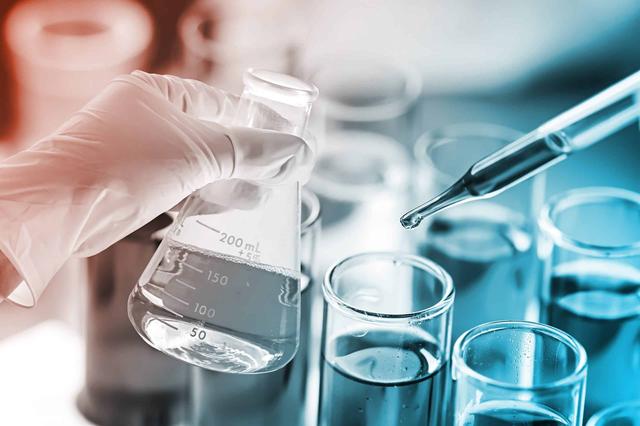Definitionofchemicalreagents
Chemicalreagentshavebeenwidelyusedinindustry,agriculture,medicalandhealth,lifesciences,inspectionandquarantine,environmentalprotection,energydevelopment,nationaldefenseandmilitaryindustry,Scientificresearchandallwalksoflifeinthenationaleconomy,butwhatisa"chemicalreagent",whatcontentitcontains,anditisstillaverydifficultthingtogiveitanaccuratedefinition.Earlychemicalreagentsonlyreferto"purechemicalsusedtodeterminethecompositionorcompositionofsubstancesinchemicalanalysisandchemicaltests."Itwaslaterexpandedto"chemicalsusedtoachievechemicalreactions",andthechemicalsreferredtoby"chemicalreagents"havelonggonebeyondthiscategory.Somepeoplethinkthat"chemicalsusedinscientificexperiments"canbecalled"chemicalreagents."Amorecomprehensivedefinitionofchemicalreagentscanbe:compoundsorelementsofvariouspuritylevelsusedinchemicaltests,chemicalanalysis,chemicalresearchandothertests.
Currentnationalstandards
GB/T14305-1993chemicalreagentcyclohexane
GB15346-1994chemicalreagentpackagingandmarking
GB/T15347-1994chemicalreagentascorbicacid
GB/T15895-1995chemicalreagent1,2-dichloroethane
GB/T15896-1995chemicalreagentformicacid
GB/T15897-1995chemicalreagentcalciumcarbonate
GB/T15898-1995chemicalreagentcobaltnitratehexahydrate(cobaltnitrate)
GB/T15899-1995Chemicalreagentmanganesesulfatemonohydrate(manganesesulfate)
GB/T15901-1995Chemicalreagentcopperchloridedihydrate(copperchloride)
GB/T629-1997chemicalreagentsodiumhydroxide
GB/T1264-1997chemicalreagentsodiumfluoride
GB/T640-1997chemicalreagentsodiumbicarbonate
GB/T671-1998chemicalreagentmagnesiumsulfate
GB/T689-1998chemicalreagentpyridine
GB/T1401-1998chemicalreagentdisodiumedetate
GB/T1268-1998chemicalreagentsodiumthiocyanate
GB/T642-1999chemicalreagentpotassiumdichromate
GB/T649-1999chemicalreagentPotassiumbromide
GB/T684-1999chemicalreagenttoluene
GB/T1276-1999chemicalreagentammoniumfluoride
GB/T2305-2000Chemicalreagentphosphoruspentoxide
GB/T6684-2002chemicalreagent30%hydrogenperoxide
GB/T678-2002chemicalreagentethanol(absoluteethanol)
GB/T12591-2002chemicalreagentether
GB/T682-2002chemicalreagentchloroform
GB/T679-2002chemicalreagentethanol(95%)
PreparationofGB/T601-2002chemicalreagentstandardtitrationsolution
PreparationofpreparationsandproductsusedinGB/T603-2002chemicalreagenttestmethod
GB/T602-2002PreparationofStandardSolutionforImpurityDeterminationofChemicalReagents
GB/T652-2003ChemicalReagentBariumChloride
GB/T1265-2003chemicalreagentsodiumbromide
GB/T606-2003chemicalreagentwaterdeterminationgeneralmethodKarlFischermethod
GB/T674-2003chemicalreagentPowderedcopperoxide
GB/T656-2003chemicalreagentammoniumdichromate
GB/T16493-1996chemicalreagenttrisodiumcitratedihydrate(trisodiumcitrate)
GB/T16494-1996chemicalreagentxylene
GB/T16496-1996chemicalreagentpotassiumsulfate
GB/T16983-1997chemicalreagenttwoMethylchloride
GB/T17521-1998ChemicalreagentN,N-dimethylformamide
GB/T615-2006Generalmethodforthedeterminationofboilingrangeofchemicalreagent
GB/T9721-2006GeneralRulesofChemicalReagentMolecularAbsorptionSpectrophotometry(UVandVisibleLightPart)
GB/T1263-2006ChemicalReagentDisodiumHydrogenPhosphateDodecahydrate(DisodiumHydrogenPhosphate))
GB/T1266-2006chemicalreagentsodiumchloride
GB/T617-2006generalmethodforthedeterminationofmeltingpointrangeofchemicalreagent
GB/T9722-2006GeneralPrinciplesofGasChromatographyforChemicalReagents
GB/T605-2006GeneralMethodforChromaticityDeterminationofChemicalReagents
GB/T614-2006GeneralMethodforDeterminationofRefractiveIndexofChemicalReagents
p>GB/T622-2006ChemicalReagentHydrochloricAcid
GB/T626-2006ChemicalReagentNitricAcid
GB/T616-2006GeneralMethodforBoilingPointDeterminationofChemicalReagents
GB/T9739-2006Chemicalreagentirondeterminationgeneralmethod
GB/T683-2006Chemicalreagentmethanol
GB/T611-2006ChemicalreagentdensityGeneralmethodofdetermination
GB/T618-2006Generalmethodfordeterminationofcrystallizationpointofchemicalreagents
GB/T673-2006Chemicalreagentofarsenictrioxide
GB/T609-2006Generalmethodfordeterminationoftotalnitrogeninchemicalreagents
GB/T637-2006Chemicalreagentsodiumthiosulfatepentahydrate(sodiumthiosulfate)
GB/T672-2006Chemicalreagentmagnesiumchloridehexahydrate(magnesiumchloride)
GB/T658-2006Chemicalreagentammoniumchloride
GB/T621-1993ChemicalReagentHydrobromicAcid
GB/T9725-2007GeneralRulesforPotentiometricTitrationofChemicalReagents
GB/T9726-2007GeneralRulesforDeterminationofPotassiumPermanganateSubstancesReducedbyChemicalReagents
GB/T9732-2007Generalmethodforthedeterminationofammoniumwithchemicalreagents
GB/T9730-2007Generalmethodforthedeterminationofoxalatewithchemicalreagents
GB/T9724-2007GeneralrulesforthedeterminationofpHvalueofchemicalreagents
GB/T9729-2007Generalmethodforthedeterminationofchlorideinchemicalreagents
GB/T631-2007Ammoniawaterforchemicalreagents
GB/T613-2007Generalmethodfordeterminationofspecificopticalpower(specificopticalrotation)ofchemicalreagents
GB/T638-2007Chemicalreagentstannouschloridedihydrate(Ⅱ)(stannouschloride)
GB/T6685-2007chemicalreagenthydroxylaminechloride(hydroxylaminehydrochloride)
GB/T625-2007chemicalreagentsulfuricacid
GB/T676-2007ChemicalReagentAceticAcid(GlacialAceticAcid)
GB/T9731-2007ChemicalReagentGeneralMethodforDeterminationofSulfurCompounds
GB/T1272-2007ChemicalReagentPotassiumIodide
GB/T9727-2007Generalmethodforthedeterminationofphosphateinchemicalreagents
GB/T10726-2007Generalmethodforthedeterminationofmetalimpuritiesbychemicalreagentsolventextraction-atomicabsorptionspectrometry
GB/T9723-2007GeneralRulesofFlameAtomicAbsorptionSpectrometryforChemicalReagents
GB/T670-2007ChemicalReagentSilverNitrate
GB/T12589-2007ChemicalReagentEthylAcetate
p>GB/T665-2007ChemicalReagentAnhydrousCopperSulfate(Ⅱ)(CopperSulfate)
GB/T9728-2007GeneralMethodforDeterminationofSulfateinChemicalReagents
GB/T633-1994chemicalreagentsodiumnitrite
GB/T650-1993chemicalreagentpotassiumbromate
GB/T1279-2008chemicalreagentironsulfatedodecahydrate(Ⅲ)Ammonium
GB/T2304-2008chemicalreagentarsenic-freezincparticles
GB/T9734-2008chemicalreagentaluminumdeterminationgeneralmethod
GB/T9855-2008chemicalreagentcitricacidmonohydrate(citricacid)
GB/T696-2008chemicalreagenturea(urea)
GB/T660-1992chemicalreagentammoniumthiocyanate
GB/T1291-2008chemicalreagentpotassiumhydrogenphthalate
GB/T10705-2008Chemicalreagent5-sulfosalicylicaciddihydrate(5-sulfosalicylicacid)
GB/T9854-2008Chemicalreagentoxalicaciddihydrate(oxalicacid)
GB/T610-2008chemicalreagentgeneralmethodfordeterminationofarsenic
GB/T1273-2008chemicalreagentpotassiumhexacyanoferrate(Ⅱ)trihydrate(potassiumferrocyanide)
GB/T9742-2008Generalmethodfordeterminationofsilicateinchemicalreagents
GB/T9741-2008Generalmethodfordeterminationofignitionresiduesinchemicalreagents
GB/T9737-2008GeneralRulesfortheDeterminationofEasilyCarbonizedSubstancesinChemicalReagents
GB/T9740-2008GeneralMethodforDeterminationofEvaporationResiduesinChemicalReagents
GB/T632-2008ChemicalReagentSodiumTetraborateDecahydrate(tetraborateSodium)
GB/T2306-2008chemicalreagentpotassiumhydroxide
GB/T639-2008chemicalreagentanhydroussodiumcarbonate
GB/T15894-2008Chemicalreagentpetroleumether
GB/T1292-2008Chemicalreagentammoniumacetate
GB/T686-2008Chemicalreagentacetone
GB/T690-2008chemicalreagentbenzene
GB/T1294-2008chemicalreagentL(+)-tartaricacid
GB/T9733-2008chemicalreagentcarbonylcompounddeterminationgeneralmethod
GB/T9735-2008Generalmethodforthedeterminationofheavymetalsinchemicalreagents
GB/T9736-2008Generalmethodforthedeterminationofacidityandalkalinityofchemicalreagents
GB/T9738-2008Generalmethodfordeterminationofwater-insolublematterinchemicalreagents
GB/T15355-2008Chemicalreagentnickelchloridehexahydrate(nickelchloride)
GB/T643-2008ChemicalreagenthighmanganesePotassiumacid
GB/T3914-2008Chemicalreagentanodicstrippingvoltammetrygeneralrules
GB/T12590-2008Chemicalreagentn-butanol
GB/T9853-2008Chemicalreagentanhydroussodiumsulfate
GB/T667-1995Chemicalreagentzincnitratehexahydrate(zincnitrate)
GB/T669-1994ChemistryReagentstrontiumnitrate
GB/T685-1993chemicalreagentformaldehydesolution
GB/T691-1994chemicalreagentaniline
GB/T693-1996chemistryReagentsodiumacetatetrihydrate(sodiumacetate)
GB/T694-1995chemicalreagentanhydroussodiumacetate
GB/T11547-2008plasticliquidchemicalreagentresistancedetermination
GB/T23942-2009ChemicalReagentGeneralPrinciplesofInductivelyCoupledPlasmaAtomicEmissionSpectrometry
GB/T657-2011ChemicalReagentAmmoniumMolybdateTetrahydrate(AmmoniumMolybdate)
p>
GB/T659-2011chemicalreagentammoniumnitrate
GB/T1281-2011chemicalreagentbromine
GB/T623-2011chemicalreagentperchloricacid
GB/T644-2011chemicalreagentpotassiumhexacyanoferrate(Ⅲ)potassiumferricyanide(potassiumferricyanide)
GB/T661-2011chemicalreagentironsulfatehexahydrate(Ⅱ)Ammonium(ammoniumferroussulfate)
GB/T646-2011chemicalreagentpotassiumchloride
GB/T664-2011chemicalreagentferroussulfateheptahydrate(ferroussulfate)
GB/T620-2011chemicalreagenthydrofluoricacid
GB/T688-2011chemicalreagentcarbontetrachloride
GB/T647-2011Chemicalreagentpotassiumnitrate
GB/T636-2011Chemicalreagentsodiumnitrate
GB/T677-2011Chemicalreagentaceticanhydride
GB/T666-2011Chemicalreagentzincsulfateheptahydrate(zincsulfate)
GB/T1271-2011Chemicalreagentpotassiumfluoridedihydrate(potassiumfluoride)
GB/T641-2011Chemicalreagentpotassiumperoxodisulfate(potassiumpersulfate)
GB/T655-2011chemicalreagentammoniumpersulfate
GB/T15354-2011chemicalreagenttributylphosphate
p>GB/T645-2011chemicalreagentpotassiumchlorate
GB/T653-2011chemicalreagentbariumnitrate
GB/T628-2011chemicalreagentboricacid
GB/T687-2011chemicalreagentglycerol
GB/T675-2011chemicalreagentiodine
GB/T651-2011chemicalreagentpotassiumiodate
GB/T1274-2011Chemicalreagentpotassiumdihydrogenphosphate
GB/T648-2011Chemicalreagentpotassiumthiocyanate
GB/T1288-2011Chemicalreagentpotassiumsodiumtartratetetrahydrate(potassiumsodiumtartrate)
GB/T1267-2011chemicalreagentsodiumdihydrogenphosphatedihydrate(sodiumdihydrogenphosphate)
GB/T654-2011chemicalreagentbariumcarbonate
GB/T1270-1996chemicalreagentcobaltchloridehexahydrate(cobaltchloride)
GB/T1278-1994chemicalreagentammoniumbifluoride
GB/T1282-1996Chemicalreagentphosphoricacid
GB/T1285-1994Chemicalreagentcadmiumchloride
GB/T1289-1994Chemicalreagentsodiumoxalate
GB/T1396-1993chemicalreagentammoniumsulfate
GB/T1397-1995chemicalreagentpotassiumcarbonate
GB/T1400-1993chemicalreagenthexamethylenetetramine
GB/T13353-1992Determinationoftheresistanceofadhesivestochemicalreagents.MetalsandmetalsTitle:
Content-basedtitle
Standardsubstance,standardsolution,standardimpuritysolution,standardreferencesubstance,standardsample,linestandardreagent,indicatorreagent,referencesubstance,benchmarkReagents,chemicalstandards,chemicalstandards,instrumentstandards,analyticalreagents,first-classreagents,second-classreagents,ultra-purereagents,high-purityreagents,equivalentreagents,pharmaceuticalstandards,pesticidestandards,spectralpurity,chromatographicpurity,electronicpurity,steelstandardsSample,pigironstandardsample,coalstandardsample,orestandardsample,etc...
Appellationbasedonusage
Chemicalreagents,generalreagents,analyticalreagents,diagnosticreagents,teachingreagents,Experimentalreagents,separationtools,buffersolutions,indicatorreagents,biologicalstains,photosensitivematerials,syntheticreagents,intermediates,chemicalrawmaterials,waterqualityanalysis,residualpesticidetesting,molecularbiologyreagents...
Source-basedtitles
Importedreagents,naturalextracts,extracts,drypowders,extracts...
Custom-basedtitles
Chemicals,Finechemicals,pharmaceuticals,coldpartialreagents,specialreagents,first-classreagents,second-classreagents,third-classreagents,smallvarietyreagents...
Appellationsbasedonproperties
Inorganicreagents,organicreagents,isotopesandlabeledcompounds,biochemicalreagents,aminoacidsandtheirderivatives,proteinsandpeptides,nucleotidesandtheirderivatives,monosaccharidesandpolysaccharides,enzymesandcoenzymes,antibiotics,vitamins,dyesandpigments,TrainingNutrients,chromatographicmedia,electrophoresismedia,biologicalbuffers...
Classificationbasis
Thecategoriesofchemicalreagentsarebasicallyclassifiedaccordingtotheirpurposeorsubjectmatter.Manynewcategorieshavebeenadded.Germany'sE.Merckcompanyisdividedinto20categoriesand88sub-categories.AmericanBaker(J.T.Baker)companyhas75majorcategoriesand124sub-categories.Withthedevelopmentofscienceandtechnology,thevarietyofchemicalreagentsisbecomingmoreandmorediverse,andthetrendofcategorydivisionisgettingmoreandmoredetailed,andithasreachedtheserializationandmatchingofvarieties.
QualityIndex
Thequalitylevelsofchemicalreagentsarecomplexandtherearemanyvarieties,whichareparticularlyconfusing.Thegeneralconventionalvarieties(class1reagents)areessentialvarieties,andthereare225species,whicharebasicallycomplementaryproducedinmycountry'schemicalreagentbasesinBeijing,Tianjin,Shanghai,Xi'an,Chengdu,Guangzhou,andShenyang.TypeIIreagentsareusedinalmostallfields,andtheyarealsonecessaryvarietiesformanufacturers.Thereareabout1800-2000varieties.Suchreagentsareinlargedemandandwidelyused.Thereareabout3000-6000varietiesofthethreetypesofreagents,andmostoftheirapplicationfieldsarerelatedtothenationaleconomyandpeople'slivelihood,suchaschemical,metallurgy,electricpower,food,medicineandhealthandotherindustriesthatarespecificallyusedinindustryreagents.
Inmycountry,thereare225kindsofchemicalreagentsrepresentedbythreegrades:premiumgrade,analyticalgrade,andchemicalgrade,accordingtothenationalstandardsofthePeople’sRepublicofChinaandthestandardsissuedbytheformerMinistryofChemicalIndustry.These225kindsofchemicalreagents,intheformofstandards,stipulatethebasisofthecontentofchemicalreagentsinourcountry.Thecontentdeterminationofotherchemicalsisbasedonthis,andthecontentisdeterminedbymeasurement.Therefore,thequalityofthesechemicalreagentsisveryimportant.Atthesametime,these225chemicalreagentshavebecomebasicvarietiesduetotheirextremelywideuse.These225specieshavebeenmarkedinthecatalogofchemicalreagents.Inaddition,therearespecialreagents,theproductionvolumeisverysmall,almoston-demandproduction,thequantityisgenerallydesignatedbytheuser.
Commonqualitylevels
Excellentgradepure(GR,greenlabel):highcontentofmaincomponents,highpurity,suitableforpreciseanalysisandresearchwork,andsomecanbeusedasbenchmarkssubstance.
Analyticalpurity(AR,redlabel):highcontentofmaincomponents,highpurity,lowinterferenceimpurities,suitableforindustrialanalysisandchemicalexperiments.EquivalenttoforeignACSlevel(AmericanChemicalSocietystandard)
Chemicalpurity(CP,bluelabel):highcontentofmaincomponents,highpurity,presenceofinterferingimpurities,suitableforchemicalexperimentsandsyntheticpreparation.
Experimentalpure(LR,yellowlabel):highcontentofmaincomponents,poorpurity,nochoiceofimpuritycontent,onlysuitableforgeneralchemicalexperimentsandsyntheticpreparation.
Indicatorsandstains(IDorSR,purplelabel):requiresuniquesensitivity.
Designatedlevel(ZD):Chemicalreagentscustomizedforspecificusersinaccordancewiththequalitycontrolindicatorsrequiredbyusers.
Electronicpure(MOS):suitablefortheproductionofelectronicproducts,withextremelylowelectricalimpuritycontent.
Equivalentreagents(3N,4N,5N):themaincomponentcontentisrespectively99.9%,99.99%,99.999%ormore.
Spectralpurity:thepurityofthemaincomponentsis99.99%
Leveldescription:
Chinese | English | Abbreviationorabbreviation |
Superiorpurereagent | Guaranteedreagent | GR |
Analyticalreagent | Analytialreagent | AR |
Chemicalpurereagent | Chemicalpure | CP |
Experimentalreagents | Laboratoryreagent | LR |
Pure | Pure | PurumPur |
Highpuritysubstance(Extrapure) | Extrapure | EP |
SpecialPure | Purissimum | Puriss |
Ultrapure | Ultrapure | UP |
Refined | Purifed | Purif |
SpectralPure | UltravioletPure | UV |
Spectrumpure | Spectrumpure | SP |
Flashingpure | ScintillationPure | |
Researchgrade | Researchgrade | |
Biochemicalreagents | Biochemical | BC |
Biologicalreagents | Biologicalreagent | BR |
Biologicalstain | Biologicalstain | BS |
Biologicalstain | Forbiologicalpurpose | FBP |
Fortissuemediumpurpose | Fortissuemediumpurpose | |
Formicrobiological | Formicrobiological | FMB |
Formicroscopicpurpose | Formicroscopicpurpose | FMP |
Forelectronmicroscopy | Forelectronmicroscopy | |
Forlensblooming | Forlensblooming | FLB |
Industrial | Technicalgrade | Tech |
Internship | Praticaluse | Pract |
Foranalysis | Proanalysis | PA |
Forprecisionanalysis | Superspecialgrade | SSG |
Forsynthesis | Forsynthesis | FS |
Forscintillation | Forscintillation | Scint |
Forelectrophoresisuse | Forelectrophoresisuse | |
Forrefractiveindexmeasurement | Forrefractiveindex | RI |
colordeveloper | Developer | |
Indicator | Indicator | Ind |
Coordinationindicator | Complexonindicator | Complexind |
Fluorescentindicator | Fluoresceneindicator | Fluorind |
RedoxindicatorAgent | Redoxindicator | Redoxind |
Adsorptionindicator | Adsorptionindicator | Adsorbind |
Referencereagent | Primaryreagent | PT |
Spectralstandardmaterial | Spectrographicstandardsubstance | SSS |
Atomicabsorptionspectroscopy | Atomicadsorptionspectorm | AAS |
Infraredabsorptionspectrum | Infraredadsorptionspectrum | IR |
Nuclearmagneticresonancespectrum | Nuclearmagneticresonancespectrum | NMR |
Organicanalyticalreagent | Organicanalyticalreagent | OAS |
Microanalyticalreagent | Microanalyticalstandard | MAS |
MicroAnalysisStandard | Microanalyticalstandard | MAS |
Spottingreagent | Spot-testreagent | STR |
GasChromatography | Gaschromatography | GC |
液Liquidchromatography | Liquidchromatography | LC |
Highperformanceliquidchromatography | Highperformanceliquidchromatography | HPLC |
GasLiquidChromatography | Gasliquidchromatography | GLC |
Gasliquidchromatography p> | Gassolidchromatography | GSC |
Thinlayerchromatography | Thinlayerchromatography | TLC |
Gelpermeationchromatography | Gelpermeationchromatography | GPC |
Chromatographyuse | Forchromatographypurpose | FCP |
AmericanChemicalSociety | AmericanChemicalSociety | ACS |
Superiorgradepure—GR
MicroorganismUse—FMB
AnalysisPure-AR
Industrial-TECH
ChemicalPure—CP
Internship—PRACT
Experimentallevel—LR
Forsynthesis—FS
Biochemicalgrade—BC
Indicator—IND
HighperformanceLiquidchromatography—HPLC
Gaschromatography—GC
Biologicalstaining—BS
Liquidchromatography—LC
Baselinelevel—PT
ChromatographyUse—FCP
AtomicAbsorption—AAS
Thinlayerchromatography—TLC
Infraredabsorption—IR
SpectrumPure—SP
NuclearMagneticResonance—NMR
SpectroscopyPure—UV
Fluorescenceanalysis—FIA
Synthesis—SYN
Inorganicanalyticalreagentsarecommonlyusedinorganicchemicalsforchemicalanalysis.Itspurityishigherthanthatofindustrialproducts,withlessimpurities.
Organicreagentsforinorganicanalysisarespecialorganiccompoundssuchasprecipitationagents,extractants,chelatingagentsandindicatorsforthedetermination,separationandenrichmentofelementsintheanalysisofinorganicsubstances,Ratherthangeneralsolvents,organicacidsandorganicbases.Theseorganicreagentsmusthavegoodsensitivityandselectivity.Withthedevelopmentofanalyticalchemistryandchemicalindustry,suchreagentswithbettersensitivityandselectivitywillbedeveloped,suchasthosethathavecomplexingabilityforsomemetals(suchasalkalimetals,alkalineearthmetals)andammoniumionssince1967.ThisisthecasewithCrownethercompounds.
Primarystandardsarecompoundswithhighpurity,lessimpurities,goodstabilityandconstantchemicalcomposition.Inthereferencereagents,thereareclassificationssuchasvolumetricanalysis,pHmeasurement,andcalorificvaluemeasurement.Eachcategoryisdividedintothefirstbenchmarkandtheworkingbenchmark.AllthefirstbenchmarksmustbeverifiedbytheNationalAcademyofMetrology,andtheproductionunitusesthefirstbenchmarkasthemeasurementstandardforworkbenchmarkproducts.Thebenchmarkreagentsforcommercialoperationsmainlyrefertothevolumetricanalysisworkbenchmarksinthevolumetricanalysiscategory[contentrangeis99.95%to100.05%(weighttitration)].Generallyusedtocalibratethetitrant.
Standardsubstanceisachemicalsubstanceusedforcomparisoninchemicalanalysisandinstrumentanalysis,orachemicalusedtocalibrateaninstrument.Itschemicalcomposition,content,physicalandchemicalpropertiesandimpuritiesmustbeknown,andmeettheregulationsorberecognized.
ReagentMicro-analyticalreagent(Micro-analyticalreagent)issuitableforthedeterminationofthesubstance,theallowableamountisonlyaconstantonepercent(weightisabout1~15mg,volumeisabout0.01~2ml)Reagentsformicroanalysis.
Organicanalyticalstandardsarechemicalreagentsusedforcomparisonwhendeterminingthecompositionandstructureoforganiccompounds.Itscompositionmustbeaccuratelyknown.Itcanalsobeusedformicroanalysis.
Pesticideanalyticalstandards(Pesticideanalyticalstandards)aresuitableforuseingaschromatographytoanalyzepesticidesordeterminepesticideresiduesascomparisonitems.Itscontentisrequiredtobeprecise.Therearesolutionspreparedfromatraceamountofasinglepesticide,andtherearealsomixedsolutionspreparedfrommultiplepesticides.
Refractiveindexliquid(Refractiveindexliquid)isahigh-puritystableliquidwithaknownrefractiveindex,usedtodeterminetherefractiveindexofcrystallinesubstancesandminerals.Therefractiveindexismarkedontheoutsideofeachpackage.
Normalsolutionisanaqueoussolutioncontainingonegramequivalentofsoluteinoneliterofsolution,thatis,asolutionwithaconcentrationof1N.IndicatorIndicator(Indicator)isasubstancethatcanchangeitscolorundertheinfluenceofthepresenceofcertainsubstances.Itismainlyusedtoindicatetheendpointoftitrationinvolumetricanalysis.Generallycanbedividedintoacid-baseindicator,redoxindicator,adsorptionindicatorandsoon.Inadditiontoanalysis,theindicatorcanalsobeusedtotestthepresenceofcertainharmfulandtoxicsubstancesingasesorsolutions.
Testpaperisasmalldrypieceofpapersoakedinanindicatororreagentsolution.Itisusedtotestthepresenceofacertaincompound,elementorioninthesolution.Itisalsousedformedicaldiagnosis.Instrumentalanalyticalreagents
Instrumentalanalyticalreagentsarereagentsusedintheprocessofsampleanalysisusingspecialinstrumentsdesignedaccordingtotheprinciplesofphysics,chemistryorphysicalchemistry.Atomicabsorptionspectroscopystandards
Atomicabsorptionspectroscopystandardsareusedasstandardreagentswhenanalyzingsamplesbyatomicabsorptionspectroscopy.
Forchromatographyreagentsforchromatographyrefertoreagentsandmaterialsusedingaschromatography,liquidchromatography,gas-liquidchromatography,thin-layerchromatography,columnchromatographyandotheranalyticalmethods.Therearestationaryliquids,Supports,solvents,etc.
Forelectronmicroscopy(Forelectronmicroscopy)reagentsarefixatives,embeddingagents,stainsandotherreagentsusedinthefieldsofbiology,medicine,etc.,whenelectronmicroscopesareusedforresearchwork.
SolventforNMRspectroscopy(SolventforNMRspectroscopy)ismainlyadeuteratedsolvent(alsocalledheavyhydrogenreagentordeuteratedreagent),whichisthehydrogenintheorganicsolventstructureisdeuterated(heavyHydrogen)replacedbythesolvent.Innuclearmagneticresonanceanalysis,thedeuteratedsolventmaynotshowpeaks,anditwillnotinterferewiththehydrogenspectrumanalysisofthesample.
Forpolarography(Forpolarography)reagentsrefertothereagentsneededforquantitativeandqualitativeanalysisbypolarography.
SpectralpuritySpectrographyreagentsusuallyrefertoreagentswithhigherpuritythathavebeenanalyzedbyemissionspectroscopy.
Spectrophotometricpurereagentreferstothesolutionusedwhenspectrophotometricanalysisisused.Ithasacertainwavelengthtransmittanceandisusedforqualitativeandquantitativeanalysis.
BiochemicalreagentsBiochemicalreagentsrefertobiologicalmaterialsororganiccompoundsrelatedtolifescienceresearch,aswellasreagentsforclinicaldiagnosisandmedicalresearch.Duetothewiderangeandrapiddevelopmentoflifesciences,thiskindofreagentshasawidevarietyandcomplexproperties.
Otherlevels
Inaddition,itisstilldividedintothefollowingmorethan20levels.
AASatomicabsorptionspectroscopy,BCbiochemicalreagents,BPBritishPharmacopoeia,BRbiologicalreagents,BSbiologicalstains,CRchemicalreagents,EPultra-pure,FCPchromatography,FMPmicroscopy,FSsynthesis,GCgaschromatography,GRsuperiorgradepurereagent,HPLChighpressureliquidchromatography,IDindicator,IRinfraredabsorptionspectrum,MARtraceanalysisreagent,NMRnuclearmagneticresonancespectroscopy,OASorganicanalysisstandard,PAanalysis,Practpractice,PTstandardReagents,Purissspecialpure,Purumpure,SPspectralpure,Techindustrialuse,TLCthinlayerchromatography,UPultra-pure,USPUnitedStatesPharmacopoeia,UVultravioletspectrophotometrypure,JXteachingreagent...MIpharmaceuticalgrade,Iindustrialgrade,FFoodgrade,Mcosmeticgrade,Ssolid,Lliquid,Efineproduct,Ccrudeproduct...
Obviously,thegeneralqualitystandardsofthesechemicalreagentsaredividedintotheabove-mentionedqualitylevels,whichisfarfrombeingsatisfied.Researchandproductionneeds.

Validityperiodofchemicalreagents
Chemicalreagentsareaffectedbyexternalfactorssuchastemperature,lightirradiation,airandwaterduringstorage,transportationandsales,andarepronetodeliquescent,Physicalandchemicalchangessuchasmycin,discoloration,polymerization,oxidation,volatilization,sublimationanddecompositionmakeitinvalidandunusable.Therefore,itisnecessarytoadoptreasonablepackaging,appropriatestorageconditionsandtransportationmethodstoensurethatthechemicalreagentsdonotdeteriorateduringstorage,transportationandsales.Somespecialrequirementsforstorageandtransportationshouldbehandledinaccordancewithspecialrequirements.Somechemicalreagentshaveacertainshelflife,sobecarefulwhenusingthem.
Thevalidityperiodofchemicalreagentsvariesgreatlywiththechemicalpropertiesofchemicals.Undernormalcircumstances,chemicallystablesubstanceshavealongershelflifeandsimplerstorageconditions.
StabilityJudgmentPrinciples
Forpreliminaryjudgmentofthestabilityofasubstance,thefollowingprinciplescanbefollowed:
Inorganiccompounds,aslongastheyareproperlystored,thepackagingisintact,Canbeusedforalongtime.However,thosesubstancesthatareeasilyoxidizedanddeliquescentcanonlybestoredforashortperiodoftime(1to5years)underdark,cool,anddryconditions,dependingonwhetherthepackagingandstorageconditionscomplywiththeregulations.
Organiclow-molecular-weightcompoundsaregenerallymorevolatile,andthepackaginghasbetterairtightnessandcanbestoredforalongtime.Butitiseasytobeoxidized,decomposedbyheat,easytopolymerize,photosensitivesubstances,etc.
Organicpolymers,especiallylifematerialssuchasoils,polysaccharides,proteins,enzymes,peptides,etc.,areextremelysusceptibletotheeffectsofmicroorganisms,temperature,andlight,andlosetheiractivityordeteriorate.Therefore,theymustberefrigerated(Frozen)preserved,andthetimeisshorter.
Inprinciple,referencematerials,referencematerialsandhigh-puritymaterialsshouldbestoredinstrictaccordancewiththepreservationregulationstoensurethatthepackagingisintact,avoidbeingaffectedbythechemicalenvironment,andthestoragetimeshouldnotbetoolong.Ingeneral,thereferencesubstancemustbeusedwithinthevalidityperiod.
Thestabilityofmostchemicalsisstillrelativelygood,andthespecificconditionsshouldbedeterminedbyactualuserequirements.Iftheanalysisdataisgenerallyunderstood,ortheanalysisresultsdonothavespecificandaccuraterequirements,suchasgeneralteachingexperiments,generalrequirementscanbemadeforthequalitylevelofchemicalreagents.However,thefactorytestdataisusedtoguideproduction,andthequalityindicatorsofchemicalreagentsmustnotbeambiguous.Asforthechemicalreagentsusedingeneralsyntheticpreparation,inmostcases,theuseofindustrial-gradechemicalreagentsissufficient.However,thesyntheticpreparationofresearch-typeandcertainspecialchemicals,insomecases,hasverystrictrequirementsonthequalityofrawmaterialsandrequiresstrictcontrol.
Inactualuse,peoplearealwaysaccustomedtojudgingtheeffectivenessofchemicalreagentsbythedateofproduction.Infact,itisridiculous.Forexample,inaninstitutionofhigherlearning,wehaveseenwarehousemanagerscleanoutallchemicalreagentsthathavebeenoutofthefactoryformorethan2years,andpreparethemfordestruction.Thereasonisthattheyhaveexpired.Nottomentionthehugewasteoffunds,thedestructionplanofthevariouschemicalhazardousmaterialsaloneisenoughtobeprohibitive.What'smore,commercialcompaniesarenotallowedtobuy,topreventbusinessesfrom"deceivingpeople",thesituationislamentable,andthesituationissad!Later,itissaidthattheselargequantitiesofchemicalreagentswere"deeplydugandburied".
Inshort,theeffectivenessofchemicalreagentsmustfirstbejudgedbasedonthephysicalandchemicalpropertiesofthechemicalreagentsthemselves,andthenthestorageconditionsofthechemicalreagentsshouldbeobservedvisually,andthenwhethertheycanbeusedaccordingtospecificneedsTheconclusion.
Classificationofchemicalreagents
Currentsituationinmycountry
Thereasonableclassificationofchemicalreagentsisfarfrommeetingtheneedsofscientificresearchandproductionduetothedraftingofnationalstandards,anditisseriousIthinderstheproductionofchemicalreagentsinmycountry.Relyingontheexisting227nationalstandardsandindustrystandardsalone,itisdifficulttogivesuchalargenumberofchemicalreagentstoaqualitystandard;itisimpossibleforustogiveallchemicalsanationalqualitystandard,eventomentionWhenitcomestoreagents,thefirstthingpeoplethinkofiswhetheritisanalyticallypureorchemicallypure.Evenwhenpeoplebuy,nomatterwhatthepurposeis,theydon’tbuynon-analyticalreagents.Thisisalsothereasonwhymanyvarietiesthatdonothavenationalstandards,butinexplicablyandbaselesslyendowproductswitharedARlabel.Itisalsobecauseinactualuse,inmanycases,thetrue"analyticalpurity"isnotrequired,andillegalmanufacturersdeliberatelylabeltheindustrialproductswith"analyticalpurity"toconfusethepuritylevel.Althoughqualityaccidentswillnotoccurinmostcases,butHowever,itseriouslyinterfereswiththeproductionanduseofreal"standardmaterialsandanalyticalgrades".
Furthermore,sincethenumberofconventionalchemicalsishuge,butthereareonly225varietiesclassifiedassuperiorgrade,analyticalgradeorchemicalgrade,then,whatelseisnecessary!
Thedifferencebetweenmycountryandtheworld
Internationally,thereisanincreasingtrendtolabelthegradeandpurityofchemicalreagentsaccordingtothemaincontentandphysicalconstantsofchemicals.Itisgenerallybelievedthatwhenthemaincontent,boilingpoint,meltingpoint,density,refractiveindex,andevenultraviolet,infrared,andnuclearmagneticspectraareallknown,thepurityandscopeofapplicationofasubstancecanbecompletelydetermined.Thisisthemaindifferencebetweenthelabelcontentofchemicalreagentsinmycountryandthatofforeignchemicalreagentlabels.
Actually,theso-calledchemicalreagentsarethemedicamentsusedinchemicalexperiments;thatis,thechemicalmedicamentsneededinchemicalexperiments.Theclassificationofchemicalpurityandgradecanbedeterminedaccordingtothequalitystandardsandscopeofapplicationofchemicalagents.
Classification
Accordingtothis,thefirstlevelofchemicalreagentsisdividedintofourcategories:standardreagents,biochemicalreagents,electronicreagents,andexperimentalreagents.
Theclassificationprincipleoflevel1standardnotonlyclarifiesthequalitystandard,butalsotakesintoaccountthescopeofapplicationofthechemicalreagent.
Thelevel2standardisafurtherdivisionbasedonthelevel1classification.Itisafurtherclarificationandlimitationofthelevel1standard.
tothreecriteriaarecomparedwiththeoriginaloldstandard,ormoreaccuratedeterminationofthespecifiedpurposes.
intheLevel1or2isdetermined,aqualityindicatorofthechemicalagent,andthepurposeofthisapplicationthequalityindicatorscanbeappliedalsodetermined.
SoIproposewillbepublishedasananalyticalexaminationofthecriteriaandstandards"standardreagent"qualitystandardsgiveclearnationalstandards.Theremaining"biochemicalreagents,electronicreagents,laboratoryreagents"qualityindicatorscanfollowcorporatestandards,orupdatetheincreasinglytechnologicalrequirementsofdiscretionbythemarket,sothatwechemicalsindustrywillbeabletogetoutoftheoriginal"deadset"ofoldtraditions,developmentboomingup!
standardreagentsBZ:inaccordancewithinternationalnormsandtechnicalrequirementsinordertoidentifyasastandardsubstanceanalysisarbitration.
BiochemicalsSH:preparationbiochemistryandbiochemicalsynthesis.
electrophilesDZ:generallyreferstothechemicalsandmaterialsusedinelectronicinformationindustry,includingintegratedcircuitsanddiscretedeviceschemicals,theprintedcircuitboardsupportingchemicals,chemicalsandsurfacemountdisplaychemicalsandotherdevices.
ReagentsSY:accordingtothe"maincontent"determined"syntheticreagent."Reagentsusedinthesyntheticchemistrylaboratorypreparation,separationandpurification,tomeetthegeneralrequirementsofsynthesisreagents.
tagschemicals
QualityIndexchemicalsdeterminestheapplicablerangeofchemicalreagents,soIrecommend,shouldannouncetheapprovalofa"chemicalreagentlabel"nationalstandard,thestandardagivenchemicalreagentsandstandardizedqualityindicatorsdescribethesystemwillregulatetheproductionofchemicalreagents,rationaluseofgreatsignificance.
"Chemicalreagentstag"bearinginformation:
registeredtrademark:clearlylabeledregisteredtrademarksofthemanufacturers.
QualityStandard:QualityStandardsimultaneouslydisplaycolorandpinyincodesintwoways.Colordisplayareaasalowerlabelmanufacturerinformationregion;pinyincodes(suchasBZ,SH,DZ,SY)indicatedinaprominentposition.
Chinesenameandtype:ProductnameChineseChemicalSocietyin1982published"inorganicchemicalnomenclaturesystems,""organicchemicalsnomenclaturesystem"asthemainbasis,takingintoaccountthelong-termuseofthecommonname,Productname.Andcanbedescribedasaccuratelyaspossiblegivenpatternsordosageofthechemicalagent,forexample:anaqueousalcoholsolution,powder,blocks,sticks,paste,suchasa200meshsizeoreventhelike.
EnglishName:NametoIUPAC1982Nianpublished"inorganicchemicalnomenclaturesystems,""organicchemicalsnomenclaturesystem"asthemainbasis,takingintoaccountthecommonname,tradename,long-termuse.
CASAccessionNumber:consistsof9digitsinsquarebrackets,hyphendividedintothreeparts,e.g.,[58-08-2]CASRegistryNumberiscaffeine.
=molecularformula:MolecularSimplecorrectlywritten,i.e.,theamountofmolecularformulashown,inaccordancewiththe1968publicationoftheinternationalatomicaccuratelycalculatethemolecularweight.TheNaOH=40.10.
content:percentagecontentbymassofthechemicalagentinaccordancewiththemethodspecifiedmolecularnationalstandardsorcorporatestandard,determined.The99.9%.
Packingamount:theamountofsolidmatterofthepackageisgivenmassofchemicalagent,suchas1g,5g,10g,25g,100g,250g,500g,1000glike.Theliquidorgaseouschemicalsgivenamountofpackagingvolume,suchas1ml,5ml,10ml,25ml,100ml,250ml,500ml,1000mlandthelike.
Appearance:concise,accuratetermtodescribethephysicalstateofthecolorofthechemicalagent,odor,andotherphysicalstate.
physicalconstants:sequentiallyintheordergivenphysicalconstantsmeasuredvalue"meltingpoint,boilingpoint,density,viscosity,opticalrotation,refractioncoefficient,solubility"andthelike.
whereinSpectrum:anda"UV,IR,NMRspectroscopy"othercharacteristicabsorptionpeaks.
interferingimpurities:primarilygivenmasspercentageofimpurities,inparticularthemaininterferenceaccuratemeasuredvalueofthemasspercentageofimpurities.
DGRNo:hazardousgoodsmustbemarkedDGRnumber.Productionbatch:givenproductionlotinordertofacilitatetraceability.
whereinforeigndevelopmentofchemicalreagents
tocompletedevelopment,alternatedirectionsreagentandancillaryservices
ancillarybenefits,likeimproveduserservice.Onforeignmarkets,almostindustrial,routineexperimentationandtestingprojectsinagriculture,health,environmentalprotection,scientificresearch,teaching,therearesetsofteststrip,completesolution,pre-filledcolumn,paintedsheets,variousreferencestandardandspecialeasytousetoolsandsmallequipment.Chemicalcompositionforeignmarketshasspecificreagents,suchasbasicmodulepeptide:p-aminoacids,FMOs(fluorenylmethoxycarbonylgroupZhuoyl)-aminoacidsandotheraminoacidsreagents;OrganicSynthesisbasicmodules:chloride,alcohol,phenols,aldehydes,amines,carboxylicacids,ketones,andthelike;andreagentscustomizedaccordingtouserrequirements.MostReagentCompany,fortheconvenienceofusers,butalsosupportingsalesoflaboratoryinstrumentsoftenusedinsmall-scale,securesupplies,variousmapsdata(chemicalstructure,infrared,ultraviolet,emissionspectroscopy,chromatography,etc.),compoundsafetydata,variousdataanalysisandothertestingmethods,ofwhichaconsiderableportionispublishedonCD-Rom.
Manyagentsnotonlyselltangibleproducts,butalsotechnicalconsultingbusiness,providingawiderangeoftechnicalservices,suchas:analysisandtesting,intermediatescale-up,processdesignproducts,developenvironmentalprotectionprograms.
attachedgreatimportancetoscientificresearchanddevelopment
Thereagentscompanyhasitsownresearchanddevelopmentdepartment,mostcompaniesalsodevelopwithuniversities,researchinstitutes,individualscientistsorotherwell-knowncompanies,andevenmergersthecompanyhassometechnicalexpertise,inordertoenhancethecompany'sdevelopmentandcompetitiveness.Theyhesitatetoinvestheavilyinresearchanddevelopment,scienceandtechnologyinordertosuddenlyflyfierce,intothefiercecompetitioninthemarketdominantposition.ToMerckKGaA,forexample,their1994-Foreachyearbetween1998andfundsscientificresearchanddevelopmentinvestmentaccountedfortheproportionofsaleswere9.56%,9.O%,8.18%,9.76%and10.05%,overthesameperiod,Merck(Darm.)asfollows:43.52%,43.94%,45.29%,47.0%and46.95%.
production,managementandtechnologyadvances
Mostofthecompany'sfactory,haveachievedISO9001,ISO9002,GMPorFDAqualitymanagementcertification.On-siteproductionprocess,industrialhygieneandenvironmentalprotectionwidespreadattention.Inrecentyears,withthecategoryofvarietiessupplymarketcontinuestoexpand,manyofthemorecomplextechnologyhasbeenwidelyadopted.Applicationofcomputer-aidedproduction,technology,businessmanagement,hasbeenverycommon.MostReagentCompany,arebuiltonitsownInternetsite,inadditiontoreportedcompanyhistory,institutionalstructure,businessscope,catalogandothervarieties,mainlyonlineshopping,andconstantly(aboutaweek)postedoperatingstatusofthecompany,technicalachievements,internationalcooperation,planningguidelinesandotherinformation.TheirannualfixedassetinvestmentinhugenumbertoMerckKGaA,forexample,from1994-1998theproportionofinvestmentinfixedassetssalesaccountedfor7.2%,8.4%,7.4%,6.7%,7.7%(eg:1998to624millionmarks,equivalenttoRMB2.8billionyuan).
alliancecooperation,jointoperationisatrend
varietycategoriesofchemicalagentsisextremelycomplicated,extensiveserviceside,involvingalmostalltheeconomicandtechnologicalfields,anycompany,wantstosweepreagentsallbusinessisimpossible,andreagentsalesischaracterizedbybiggerandmoreandmorevarietiesofbusiness,increasesalesopportunities,thegreaterthelikelihoodofthatisprofit.So,20yearsago,thereisatrendofsmallcompaniesmoveclosertolargecompanies,smallcompaniesorlargecorporatemergersofmutualco-operation.Headabletosupplytheworld'slargestspeciesistheSigma-A1drichcompany,theyadvantageinthevarietyisalmostirreplaceable,thisisindeedtheresultofajointoperation.
Thenewtrendinthecountrythroughtheestablishmentofe-commerceplatformtoachieveintegration,alliances,jointventureseffects,likeAvatar,chemistry,Chineseagentsspecializeine-commercetradingplatformsuchreagentshasoccurred,thiswouldbeagoodintegrationofthedomesticagentresources.Becauseitconformstothedevelopmentofonlinesalesmodel,webelievethiswillbeamajortrendinthefuturereagentsbusiness.
safeuseofchemicalreagents
1.Chemicalsflammable
GeneralChemicalsflashpointbelow25℃flammablechemicalagentsincluded,theyaremostlyhighlyvolatileliquids,incaseoffiretoburn.Thelowertheflashpoint,themoreflammable.Commonflashpointpetroleumopened,ethylcondensateethane,diethylether,gasoline,twocarbonizedcarbon,withalkylenepropionate,benzene,ethylacetate,methylacetateinthefollowingyeast-4℃.
mustnotbeusedeasilywhenusingbrightfirealkenylChemicals.Heatcannotbedirectlyheatedbyaheater,generallydonothavewaterbath,suchchemicalagentsshouldbestoredinthecoolair,intherefrigerator,therefrigeratormustbeexplosionproof,therehadbeenstoredinaconventionalrefrigeratoretherandfire,accidentburnedtheentirelaboratory,wheretheuseofsuchalargenumberofchemicalreagents,looktomaintaingoodventilation,theuseofelectricalappliancesmustbeexplosion-proofelectricalequipment,thesitemustnothaveopenflames.
highlyflammablereagentsduringcombustioncanleadtoanexplosion,chemicalreagents,suchassomesolid:nitrocellulose,picricacid,trinitrotoluene,trinitrobenzene,oroverlappingazidecompound,saltHuoandsoon,frieditselfisburning,whenexposedtoheatorflame,whichburnseasilyordecomposition,explosion,itmustnotbeheateddirectlyintheuseofthesechemicals,shouldalsopayattentionsurroundingtheuseofthesechemicalsdonothaveanopenflame.
Anothertypeofsolidchemicalreagents,waterviolentreactioncanoccur,andemitalotofheat,cancauseanexplosion.Suchchemicalagentsaremetalpotassium,sodium,lithium,calcium,aluminumhydride,calciumcarbideandthelike,intheuseofthesechemicalagentsmustavoidtheirdirectcontactwithwater.
andsomesolidoncontactwithachemicalagentastrongoxidationcanoccur.Thephosphorus;somecontactwithanoxidizingagentorheatintheair,bytheimpactorfrictioncancauseabruptcombustionorexplosion.Thephosphorussulfide,redphosphorusmagnesium,zinc,aluminum,Rong,brainandthelikefall,whenusingthesechemicalagents,wemustpayattentionnottoohighambienttemperature(typicallynotmorethan30℃,preferably20℃orless)Avoidcontactwithstrongoxidizingagents.
Inthelaboratorypersonnelusingflammablechemicals,oughttowearthenecessaryprotectiveequipment,itisbesttowearprotectiveglasses.
2.ToxicChemicals
Generalchemicalsaretoxictohumans,mustbeavoidedwhenusingthelargenumberofinhalation,theagentperformancesAfteruse,towashtheirhands,wash,bath,replacingclothesforinhalationoringestionofsomesmallamountofdeaththatcanpoisonthechemicalagent,theamountofbiologicaltestdeath(LD50)isreferredtoastoxicchemicalagentsat50mg/kgorless,suchas:potassiumcyanide,sodiumcyanideandothercyanide,arsenictrioxideandcertainarsenide,mercurydichloride,mercuryandcertainsalts,sulfate,dimethylandthelike.Whenusingclearperformancechemicals,wemustunderstanditsLD50.Firstaidtreatmentatsomeofthecommonlyusedtoxicchemicalsmustunderstandthesetoxicchemicals,toxicchemicalsmusthaveaspecialpersontokeepstrictcontrolusage.
3.Corrosivechemicalagents
anychemicalagentacrosstheskin,mucousmembranes,eyes,respiratoryorgansmustbecleaned,inparticular,haveastrongcorrosivetotheskin,mucousmembranes,eyes,respiratorychemicalagents(whetherliquidorsolid),suchas:avarietyofacidsandbases,phosphorustrichloride,phosphorusoxychloride,bromine,phenol,Tianshuihydrazineandthelike.Butalsotoavoidhittingtheskin,mucousmembranes,eyes,respiratory,usebeforeusemustunderstandaidaccesstothesetreatmentmethodscorrosivechemicalagents.Usedilutealkalisuchasacidwashing,etc.spilledontheskin.
4.StrongoxidizingChemicals
strongoxidizingchemicalagentsareperoxidecontainingoxyacidorstrongoxidizingpoweranditssalts.Suchas:acidperoxide,Annnitrate,potassiumnitrate,perchloricacidandsaltsthereof,acidandsaltsthereofcomplexweight,permanganicacidanditssalts,peroxyacid,peraceticacid,sweetwine,phosphoruspentoxideandthelike.Strongoxidizingchemicalagentsunderappropriateconditionscanemitoxygenexplosion,andformexplosivemixtureswithorganicmagnesium,aluminum,zinc,sulfurandothercombustibles,somewatermayexplode,theuseofsuchastrongoxidizingchemicalinreagent,ambienttemperatureisnothigherthan30℃,goodventilationshouldnotbeorganicorreducingsubstanceswiththeuseofcommon(heating).
5.WhenRadiochemical
Theuseofsuchchemicalagents,theuseofradioactivematerialsaccordingtoacertainmethod,totakeprotectivemeasures.
distillationandrectificationchemicals
inthechemicalanalysis,instrumentalanalysis,thepreparationofinorganic,organicsynthesisandotherscientificexperimentareoftenencounteredwithinsufficientpuritychemicalsorbuytherequiredpuritychemicals,whichrequirespurificationofourownexistingchemicalsinthelaboratoryinordertoobtaintherequiredpuritychemicals.Apolloagentwillbesmallseriesfollowingbriefdistillationandrectificationmethods.
distillationandrectification
distillationandrectificationisawidelyusedmethodofpurification,mixingthecomponentsinaccordancewiththeliquidmixturebetweenliquidandvaportheinequalityofpurified,purificationisthefirstchoiceofvolatileandsemi-volatilechemicals.
adistillationprinciple
Themainpurposeisseparatedbydistillationfromtheimpuritiescontainedinthechemicalagentvolatileandsemi-volatileimpuritiesandvolatileorsemi-volatileevaporatingbodyTheywillnotbevolatileandlessvolatileimpuritiesleftbehind.Changethesaturationvaporpressureofasubstanceatdifferenttemperaturesisthebasisoftheseparationbydistillation.Generallyspeaking,ifthevaporpressureoftheliquidmixtureoftwocomponentshavingalargedifferenceinthevaporphasecanbemorevolatileandsemi-volatilecomponentsenrichment.Twophases-liquidandvaporphases-canberecoveredseparately,volatileandsemi-volatilecomponentsintheenrichedvaporwithoutvolatilecomponentsareenrichedintheliquidphase.
Inadditiontothehydrocarbonmixtureandafewotherexamples,Raoult'slawandDalton'slawcanbeusedinsystemsoverthemixture,andthemixturesolutionisoftennotdesirabletofollowthevaporphase-phasebehavior.Applicationofthesetwolawscanbeavolatilethanthetwocomponentsofthebinarysystem(aAB):aAB=(YA/YB)/(XA/XB)=P0A/P0Bwherein,YAandYBaretheequilibriumcomponentsaandBinthegasphasemolefraction,XAandXBarethecomponentsaandBintheliquidphaseatequilibriummolefraction,andP0BareP0AvaporpressureofcomponentsaandBatequilibrium,obeysthelawsofRaouilt.WiththeincreaseaAB,alsoincreasesthedegreeofenrichment.
Second,asimpledistillation
simpledistillationapparatus,showninFigure-1.Whenaliquidsampleisheatedandconvertedintosteam,whichiscondensedpartbacktotheoriginaldistillationflask,whiletherestiscondensedandtransferredtoacollectionvessel,theformeriscalledrefluxliquid,whichiscalledeffluent.Sincethedistillationiscarriedoutcontinuously,escapeandstoredintheliquidcompositionisgraduallychanging.Asamethodofpurifyinganimpuritychemicalagents,separationonlysimpledistillationboilingpointhasalargedifference,suchastheboilingpointofthemainbodyofthedifferenceisgreaterthan50℃impurities.Toremoveimpuritieshavingaboilingpointoflessthan50deg.]Cwiththemaindifferenceis,willhavetouserectificationmethoddescribedbelow.
simpleatmosphericdistillationunitmainlyconsistsdistillationflask,thermometer,condenser,atrapandaheatingdevicewithasidetubeandothercomponents.Wheninstalled,themercurythermometershouldbeinsertedintotheballpositionlowerthanthesidetube,thesidetubeandacondenserconnectedtothedistillationflaskhorizontal,themouthandthecollectorconnectedtoacondenser(FIG.1).Whenusingadistillationapparatus,distilledaccordingtoboilingpointsoftheselectedtestchemicalheatingmeans:Thedistillationoftheliquidataboilingpointofless80℃,heatedwithhotwaterbath;liquidataboilingpointofabove100deg.]C,asbestosfireorbystraight-lineoilbath;liquidatatemperatureofabove200℃,heatingmetalbath.
distillationataboilingpointofabove150℃liquid,aircondensermaybeused.Inordertosmoothlycarryoutdistillation,andbeforeheating,thezeolitemustbeaddedaftertheliquidintheflaskchargedtotheflask.Becauseoftheverysmoothinnersurfaceoftheflask,andthebumpingpronetooverheating,sothatthedistillationcannotbecarriedoutsmoothly.Whenaddinganewzeolite,etc.mustAftercooledtoroomtemperaturebeforetheliquidwasaddedtotheflasktoavoidtheriskofboilingoccursabruptly.Zeoliteusedonlyonce,whentheliquidiscooled,addedtotheoriginalzeoliteloseseffect,sowhenthedistillationwascontinuedtobeaddedtothenewzeolite.Inatmosphericdistillation,havingaporous,easilycrushed,andthematerialwasdistilleddoesnotcausechemicalreactions,canbeusedasthezeolite.Zeolitesarecommonlycutinto1-2mmpiecesorunglazedclaytiles.
distillationapparatusisinstalled,theheatingcanbegin.Whenthesubstancebeginstoboilthedistillationflask,thetemperaturerisingsharply.Whenthetemperaturerisestotheboilingpointsubstanceweredistilleddown1℃,theintensityofheatingoftheheaterisadjustedtoalevelofadroppersecondeffluent.Inthiscase,theheatingtemperatureofthebathshouldbemaintainedathigherthantheboilingpointofthematerialinthedistillationflask20℃.Higherboilingmaterialdistillation,steamBeforei.e.lessthantheoutersidetubeandrefluxcoolingair,itcannotbedistilledoff.Atthistime,theflamecanbeuniformlyheatedusingamicrotubeofthelowersurfaceside,buttoavoidexcessiveheating,sothatthethermometerdoesnotindicatethecorrectboilingpoint,butalsoontheheatingportionoftheretortwithoutproperinsulation.Inthedistillationoperation,itshouldbenotedthefollowing:
(1)controltheheatingtemperature.Ifaheatingbath,thetemperatureoftheheatingbathshouldbeseveraldegreeshigherthantheboilingpointofthedistillationoftheliquid,otherwiseitisdifficulttobedistilledoutofthedistillate.Themoretheheatingbathtemperaturehigherthantheboilingpointoftheliquidofthedistillation,thedistillationfaster.However,thetemperatureoftheheatingbathcannotbetoohigh,otherwiseitwillleadtoanupperportionoftheretortandacondenservaporpressureaboveatmosphericpressure,anaccidentmayoccur,inparticular,moreparticularattentionduringdistillationlowboilers.Acamel,heatingbathtemperaturenothigherthantheboilingpointof30deg.]Cdistilledmaterial.
(2)distillingthehigh-boilingsubstances,condenseeasilybecause,oftendoesnotreachthevaporsideofthetube,i.e.thedistillationflaskhasbeencondenseddropsbackintothedistillationflask.Therefore,weshoulduseshort-neckedretortortakeinsulationmeasurestoensurethesmoothprogressofdistillation.
(3)priortothedistillation,thedistillationmustunderstandthechemicalagentandtheboilingpointandsaturatedvaporpressureimpurities,todeterminewhen(i.e.,atwhattemperature)tocollectpurechemicalagent.
(4)shallbeinthedistillationflaskroundbottomflask.
aboilingpointof40-150deg.]CmaybeemployedChemicalssimpledistillationundernormalpressure.Chemicalsforboilingatabove150℃oraboilingpointbelow150deg.]C,although,butthermallylabile,thermallydecomposingthechemicalagent,maybeemployedsteamdistillationandvacuumdistillation,simplybeintroducedseparately.
1.Simplevacuumdistillationapparatus,theentiresystemconsistsofKirschnerportion(aClaisen)distillationflask,condenser,accumulator,suction(vacuum)system,interfacesandothercomponents.Wheninstallingavacuumdistillationunit,itshouldbenotedthatthedeviceissealed,goodqualitycorkmustbeselectedslightlylargerthanthediameterofthestopperflask.Corkmaterialshouldbeselecteddependingonthenatureoftheliquidsamplevapor.Ifthesteamdoesnotcauseerosionoftherubberstopper,rubberstopperusingeasilyremainsealed.Whenyouuseagoodqualitymatteappliances,butalsoeasytoremainsealed.Afterthedeviceisinstalled,beforestartingthedistillation,thesealmustbecheckedtoreducedpressuredistillationapparatus.Sealingdeviceinspectionmethodisconfirmedbymeasurementofchangeinpressureofthesystem,andifthepressurevaluedoesnotchange,indicatingthedevicedoesnotleakbeforedistillationunderreducedpressure.Whendistillationunderreducedpressure,thecapillarytubemaybeinsertedinthedistillationflasktopreventbumpingphenomenon.Theupperendofthecapillarytubeissealed,thelowerendisopen.Checkthatthesealedairtightafterdistillation,thepurifiedchemicalreagenttobeaddedtotheflask,theflaskwasaddedinanamounthalfthevolume,andthesystemevacuatedtoareducedpressurestate,andheatingisstarted.Theflaskwasimmersedinaheatingbathdepth,tobesurethatthebottleisbelowtheliquidsurfacelevelofsubstancedistilledheatingbath.Especiallyinahigh-boilingmaterialdistillation,theflaskwasimmerseddeepershouldtry.Whendistillationunderreducedpressure,oftenduetothepresenceoflowboilingsolventtoproduceafoam,requirealowdegreeofvacuumintheselow-boilingsolventwasdistilledoffbydistillationatthebeginning,andthengraduallyincreasethedegreeofvacuum.Lowvaporpressuredependsonthedegreeofvacuumoftheapparatusoftheliquidsample.Beforecoolingeffectmustbewelldistillates,otherwiseitisdifficulttoincreasethevacuumsystem.
Relationshipbetweenpressureandboilingpoint,canbeapproximatedoutbythefollowingformulaisderived:logP=A+(B/T)
whereinPisthevaporpressure,Tistheabsolutetemperature,A,Bisaconstant.Inpractice,theboilingpointcanbefoundinrelatedstressFIG.Whenthedistillationiscompletedistillationboilingpointcomponentsdesired,orwhenthedistillationprocessneedstobeinterrupted,heatingshouldbestopped,theheatingbathwasremoved,andaftercooling,slowlyreleasingthevacuumsystem,theapparatustoallowairtoenterthenormalpressureoffthevacuumpump.
steamdistillationistheseparationandpurificationmethodscommonlyusedinorganicmattersample,especiallyinthepresenceofalargenumberofresinousimpuritiesinthesampleupon.Thesamplewastreatedcompositionshouldmeetthefollowingconditions:thatisinsolubleoralmostinsolubleinwater,withboilingwaterduringprolongedcoexistencenochemicalchange,musthaveavaporpressureunderconditionsofgreaterthanabout100℃of10mmHg.
steamdistillation,isanothertechniqueforproducingheat-sensitivesamplesandforpurification.Itcanalsobeusedforgoodheattransferliquidsample,willdirectlycauselocaloverheatingheating.Steamdistillationmaybecompletedbycontinuouslysteamflowsthroughthevesselinthesamplemixture.Sometimestheuserdirectlyintotheflaskwithwaterforthesamepurpose.Steamcarryinggasphasevolatilecomponentandsuchalargeconcentratedvolatilematerialrelatedtotheirvaporpressureinthevapormixtureinthevapormixture.
Thistechniqueisverymild,duringthedistillationwillnotbedistilledmaterialisheatedtohigherthanthetemperatureofthesteam.Attheendoftheprocess,thesteamiscondensedandseparatedmaterial.Typically,theyareimmiscibleandmayformtwophasesareseparated.Sometimesanalyticalchemistmusthaveanadditionalsamplepreparationtechnique,suchasfluid-tocompletelyseparateaqueousandorganiclayersmultipleliquidextraction.
2.Simplemeansofsteamdistillation,Asteamgeneratoris,asthelevelgaugeglassBcanbeseenthattheheightofthewatersurfaceoccurs.Shengwaterisgenerallyappropriatecontainervolumeof75%,iftoofull,boilingwaterrushedtotheflask.SafetyglasstubeCisalmostinsertedinthebottomofthegeneratorA.Whenthepressureinsidethecontaineristoolarge,thewatercanrisealongtheglasstube,inordertoadjusttheinnerpressure.Ifthesystemisclogged,thewaterwillbeejectedfromtheupperopeningofthetube,itshouldbecheckedatthistimethesteamconduitundertheroundbottomflaskwhethertheportisblocked.Usingtheaboverectifyingpartgenerallynecked500mlroundbottomflask.Inordertopreventtheliquidinthebottleduetosplashjumpintothecondensertubes,sothatthepositionoftheflaskwastiltedby45degreesinthedirectionofthegenerator.Bottleofliquidsampleshouldnotexceed1/3ofitsvolume.EndofthesteamintroducingpipetobebentE,itisontheverticallyoutintothebottomofthebottleandclosethecentralbottom.SteamoutletpipeF(approximately30°angled)innerdiameterEispreferablylargerthanthenumberoftubes,insertoneendofthecorkwithtwoholes,exposingapproximately5mm,andtheotherendconnectedtothecondenser.DistillateliquidpipeintothereceptaclethroughtheaccessH.Availablewaterbathcoolingtheperipheralreceptacle.
inthesteamgeneratorandtheneckedroundbottomflaskshouldbeinstalledbetweenaT-shapedpipe,connectedatthelowerendofaT-piecespringclipG,inordertotimelyremovecondensedwaterdropletsclogging.When
steamdistillation,firstthesamplesolutionwasplacedinD.HeatingthesteamgeneratortonearboilinguntilaftertheGintensifythesteamevenlyintotheroundbottomflask.InordernottocondensethesteamandexcessiveaccumulationofD,itcanbesetatanetasbestosD,ifnecessary,tomakesmallflame.Heatingratemustbecontrolledsothatallthesteamcanbecondensedinthecondenser.Ifthevolatilesubstancewithwaterhavingahighermeltingpointvaporcondensedinthesolidwaseasilyprecipitated,itshouldadjusttheflowrateofthesmallcondensateaftercondensingitremainsliquid.Ifthesolidhasprecipitated,andthenearclogging,temporarilystopstheflowofcoolingwater,coolingwaterisevennecessarytotemporarilyletgo,sothatthemeltedmaterialflowsintothereceptaclewiththewater.Itmustbenoted,whenthecondensertobere-introducedintothejacketcoolingwater,needtobecarefullyandslowlyflowsinto,topreventquenchingduetorupturecondenser.Casehasbeenblockedcondenser,distillationwasstoppedimmediately,andtrytoclear.Suchasusingaglassrodtopokeoutorcloggingofmaterialtothehotwaterinacondensersoastomeltthetankjacket.
duringdistillationifitbreaksordistillationwascomplete,thespringclipmustfirstopenthethroughGatmosphere,thenheatingwasstopped,ortheliquidsuckedD,A,willbeinverted.Duringthedistillation,thewaterlevelrisesrapidlyiffoundsafeintubeC,thencloggingoccursinthesystem,thenitshouldimmediatelyopenthespringclipG,andthentheheatwasremoved.Beexcludedbeforecontinuingpluggingsteamdistillation.
III.Rectification
fractionaldistillationiscarriedoutbyfractionaldistillationcolumninthedistillationprocess,thechemicalagentisrectifiedinthedistillationflaskafterboiling,thesteamfromthegardenbottomflaskevaporatesintoafractionatingcolumn,condensedinthefractionatingcolumnintoaliquidportion.Theliquidduetohighcontentoflow-boilingcomponents,andthereforealsolowerthantheboilingpointoftheliquidtemperatureinthedistillationflask.Whenthedistillationflasktoanotherportionofthevaporrisesinthefractionationcolumn,andthentheliquidhascondensedbyheatexchange,re-boilingit,whiletheascendingvaporispartiallycondensedinitself,andtherefore,ithasproducedanewtheliquid-vaporequilibrium,theresultsofthelow-boilingcomponentinthevaporhaveincreased.Whenthenewvaporriseswithinthedistillationcolumn,andiscondensedintoaliquid,andthenbyheatexchangewithanotherportionoftheascendingvaporboils.Duetoconstantlyascendingvaporcondensationandevaporationfractionatingthecolumn,andeachtimebothevaporationandcondensationofthesteaminthelow-boilingcomponentcontinuestoincrease.Accordingly,duringascentofsteaminthefractionatingcolumn,similarlyrepeatedaftersimpledistillationofthelowboilingcomponentthevaporgraduallyincrease.Thus,inthefractionationprocessiscriticaldephlegmatorapparatus,ifappropriateselectedfractionatingcolumncancomeoutatthetopofthefractionatingcolumnvaporcondensedandtheresultingliquidmaybeapurecomponentoralow-boilinglow-boilingaccountedeffluentmaincomponent.
fractionationcapacityandefficiencyofthefractionationcolumn,respectively,as"theoreticalplatesvalue"and"heightequivalenttheoreticalplate(theHETP)"represented.Avalueequivalenttoatheoreticalplatesimpledistillation.Thedistillationcolumnhavingafractionatingcapabilityofthesame,whichisnotnecessarilyequallength.Forexample:A,Btwodephlegmator,theirvaluesare20theoreticalplates,Aistheheightof60cmandaheightof20cmacetate.Obviously,boththeoreticalplateheightequivalentisdifferent.Becausetheheightequivalentoftheoreticalplate:
HETP=heightofthedistillationcolumn/theoreticalplatenumber
Therefore,theoreticalplatesAfractionatingcolumnheightequivalentof3cm,andacetatetheoreticalplatesfractionatingcolumnheightequivalentof1cm.Itcanbeseenthroughthisexample,theequivalentoftheoreticalplatesofthedistillationcolumnheightislower,thehigheritsefficiencyinfractionationunitlength.
Duringdistillationoperation,themainfractionatingcolumnselectedaccordingtotheleveldifferencebetweentheboilingpointandtheboilingpointofthechemicalagentintherectificationbodywithimpurities.Ifthedifferenceinboilingpointinthetwocomponentsabove100℃,afractionatingcolumnmaynotbeused;iftheboilingpointdifferenceisabout25℃,optionallyconventionalfractionatingcolumn;iftheboilingpointdifferenceisabout10℃,requireselaboratefractionatingcolumn,suchasmicro-Grofractionatingcolumnandthelike.Distillationprocessusingtheheatsourcemustbestabletoensureaheatingtemperaturestable.Onlystrictcontrolandconstantheatinginordertomaintainthedesiredrefluxratio.Ifheatedtooquickly,willproducefloodingphenomenon,thefractionationefficiencyispoor.Iftheheatingistooslow,youcanonlyplaytheroleofafractionatingcolumnrefluxcondenser,simplydistilledoutanything.Further,atthetimeofdistillation,refluxanddistillaterequiresanappropriateratio,i.e.refluxratioshouldbeappropriate,itsvalueisequaltothevalueoftheoreticalplatesfractionatingcolumnsubstantiallyso,tomakethenormaldistillationprocess.
IV.Thepracticalapplicationofdistillationandrectification
distillationandrectificationmainlyusedforliquidorheatingliquidcanbeachemicalagent,inparticularfororganicchemicalspurification.Priortodistillationorrectification,sometimestheadditionofcertainchemicalreagents,chemicalreactionwithachemicalreagenttobepurifiedofimpuritiesoccurs,generatingahigherboilingpoint(orless)substance,ismoreeasilyremovedinadistillationorrectification.
duringdistillationorrectification,isoftenthefirstdistillatefractionisremovedandthefinalremainingfraction,twoofthemoreremoved,thehigherthepurityofthechemicalagent,buttheloweryields.
